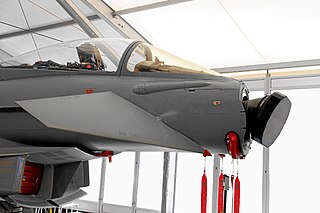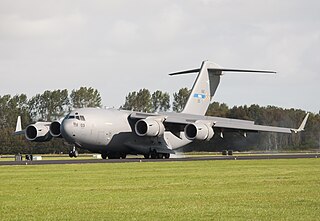Related Research Articles

The AIM-120 Advanced Medium-Range Air-to-Air Missile, or AMRAAM, is an American beyond-visual-range air-to-air missile (BVRAAM) capable of all-weather day-and-night operations. Designed with a 7-inch (180mm) diameter form-and-fit factor, and employing active transmit-receive radar guidance instead of semi-active receive-only radar guidance, it has the advantage of being a fire-and-forget weapon when compared to the previous generation Sparrow missiles. When an AMRAAM missile is launched, NATO pilots use the brevity code Fox Three.

The AGM-88 HARM is a tactical, air-to-surface anti-radiation missile designed to home in on electronic transmissions coming from surface-to-air radar systems. It was originally developed by Texas Instruments as a replacement for the AGM-45 Shrike and AGM-78 Standard ARM system. Production was later taken over by Raytheon Corporation when it purchased the defense production business of Texas Instruments.

The MIM-104 Patriot is a surface-to-air missile (SAM) system, the primary of its kind used by the United States Army and several allied nations. It is manufactured by the U.S. defense contractor Raytheon and derives its name from the radar component of the weapon system. The AN/MPQ-53 at the heart of the system is known as the "Phased Array Tracking Radar to Intercept on Target" which is a backronym for PATRIOT. The Patriot System replaced the Nike Hercules system as the U.S. Army's primary High to Medium Air Defense (HIMAD) system, and replaced the MIM-23 Hawk system as the U.S. Army's medium tactical air defense system. In addition to these roles, Patriot has been given the function of the U.S. Army's anti-ballistic missile (ABM) system, which is now Patriot's primary mission. The system is expected to stay fielded until at least 2040.

The Defense Information Systems Agency (DISA), known as the Defense Communications Agency (DCA) until 1991, is a United States Department of Defense (DoD) combat support agency composed of military, federal civilians, and contractors. DISA provides information technology (IT) and communications support to the President, Vice President, Secretary of Defense, the military services, the combatant commands, and any individual or system contributing to the defense of the United States.

Meteor is an active radar guided beyond-visual-range air-to-air missile (BVRAAM) developed by MBDA. Meteor offers a multi-shot capability against long range manoeuvring targets, jets, UAVs and cruise missiles in a heavy electronic countermeasures (ECM) environment with range well in excess of 150 kilometres (81 nmi). Its no-escape zone of over 60 km is largest among air-to-air missiles according to the manufacturer. A solid-fueled ramjet motor allows the missile to cruise at a speed of over Mach 4 and provides the missile with thrust and mid-way acceleration to target intercept. A two-way datalink enables the launch aircraft to provide mid-course target updates or retargeting if required, including data from off-board third parties. The datalink is capable of transmitting missile information such as functional and kinematic status, information about multiple targets, and notification of target acquisition by the seeker.

The IRIS-T is a German-led program to develop a short-range infrared homing air-to-air missile to replace the AIM-9 Sidewinder found in some NATO member countries. Any aircraft capable of firing the Sidewinder is also capable of launching the IRIS-T.

Air Force Space Command (AFSPC) was a major command of the United States Air Force from September 1982 to December 2019. On 20 December 2019, concurrent with the signing of the National Defense Authorization Act for 2020, it was re-designated as the United States Space Force to stand up as a new sixth service branch of the United States Armed Forces responsible for space warfare.
Orbital Sciences Corporation was an American company specializing in the design, manufacture and launch of small- and medium- class space and rocket systems for commercial, military and other government customers. In 2014 Orbital merged with Alliant Techsystems to create a new company called Orbital ATK, Inc., which in turn was purchased by Northrop Grumman in 2018. Orbital Sciences Corporation today is a subsidiary of Northrop Grumman and is known as Northrop Grumman Innovation Systems.

The Euroradar CAPTOR is a next-generation mechanical multi-mode pulse Doppler radar designed for the Eurofighter Typhoon. Development of the CAPTOR led to the Airborne Multirole Solid State Active Array Radar (AMSAR) project which eventually produced the CAESAR, now known as CAPTOR-E.
The Medium Extended Air Defense System (MEADS) is a ground-mobile air and missile defense system intended to replace the Patriot missile system through a NATO-managed development. The program is a development of the United States, United Kingdom, Germany and France.

The Missile Defense Agency (MDA) has its origins in the Strategic Defense Initiative (SDI) which was established in 1983 by Ronald Reagan which was headed by Lt. General James Alan Abrahamson. Under the Strategic Defense Initiative's Innovative Sciences and Technology Office headed by physicist and engineer Dr. James Ionson, the investment was predominantly made in basic research at national laboratories, universities, and in industry. These programs have continued to be key sources of funding for top research scientists in the fields of high-energy physics, supercomputing/computation, advanced materials, and many other critical science and engineering disciplines—funding which indirectly supports other research work by top scientists, and which was most politically viable to fund within the Military budget of the United States environment. It was renamed the Ballistic Missile Defense Organization in 1993, and then renamed the Missile Defense Agency in 2002. The current director is U.S. Navy Vice Admiral Jon A. Hill.

Missile defense is a system, weapon, or technology involved in the detection, tracking, interception, and destruction of attacking missiles. Originally conceived as a defense against nuclear-armed intercontinental ballistic missiles (ICBMs), its application has broadened to include shorter-ranged non-nuclear tactical and theater missiles.
Link 16 is a military tactical data link network used by NATO and nations allowed by the MIDS International Program Office (IPO). Its specification is part of the family of Tactical Data Links.

Nuclear sharing is a concept in NATO's policy of nuclear deterrence, which involves member countries without nuclear weapons of their own in the planning for the use of nuclear weapons by NATO. In particular, it provides for the armed forces of those countries to be involved in delivering nuclear weapons in the event of their use.

Eurosam GIE is a European manufacturer of anti-air missiles. Eurosam was established in June 1989 for the development of the Famille de missiles Sol-Air Futurs. Eurosam was initially a joint venture between Aérospatiale, Alenia and Thomson-CSF. Now Aérospatiale is a part of MBDA, and Missile and Missile Systems activities of Alenia are now the Italian branch of MBDA. Thomson CSF is now the Thales Group. Thus Eurosam is owned by MBDA France and Italy (66%) and Thales Group (33%).

The U.S. Army Corps of Engineers Europe District, (NAU) provides both installation and contingency support to U.S. forces throughout the United States European Command area of responsibility. Headquartered in Wiesbaden, Germany, the district, which is part of the North Atlantic Division, covers a widely dispersed geographic area from Western Europe across Eastern Europe, including Russia, down to Israel and throughout most of the African continent. Work is executed from offices in Germany, Belgium, Turkey, Romania, Italy, Spain, Kosovo, Israel, Bulgaria, and Georgia. In 2009, the district completed more than $1.2 billion in projects including $648 million in military construction projects. The bulk of this work included Army and Air Force Family Housing units, forward operating sites in Eastern Europe, and training and operations facilities.

The Strategic Airlift Capability (SAC) is a multinational initiative that provides its participating nations assured access to military airlift capability to address the growing needs for both strategic airlifts and tactical airlifts.
Thales-Raytheon Systems Company LLC is an aerospace and defence company co-headquartered in Massy, Paris, France and Fullerton, California, United States. It is operated as a 50:50 joint venture between Raytheon and Thales Group.
The defense industry of Russia is a strategically important sector and a large employer in Russia. It is also a significant player in the global arms market, with Russian Federation being the second largest military products exported after the USA. Russia is the second largest conventional arms exporter after the United States, with $13.5 billion worth of exports in 2012. Combined, the US and Russia account for 57% of all major weapons exports.

Michael-Bruno, LLC is an American architectural design, engineering service and construction management firm. The company is headquartered in Wilmington, Delaware, with operations in Europe, Africa, and the Middle East. Founded in 2003, they run multiple overseas operations. Michael-Bruno, LLC has won multiple contracts with NATO and the U.S. military, including the Navy.
References
- MEADS International website – MEADS program website
- – MEADS Budget Data
| This military aviation article is a stub. You can help Wikipedia by expanding it. |